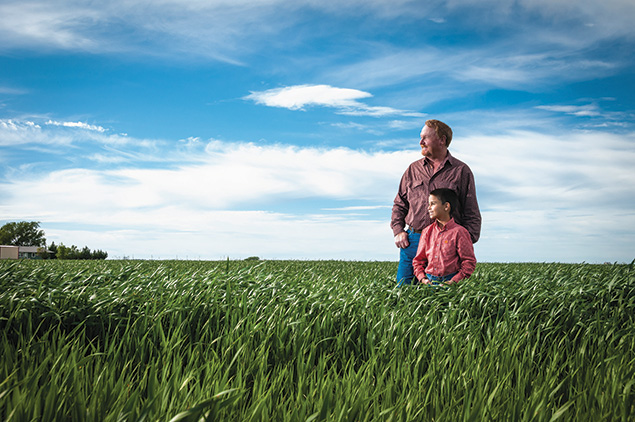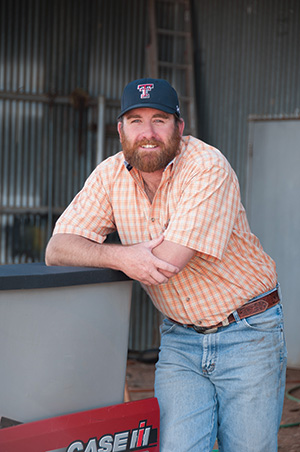
Jeff Harrell and son Luke
Photo by Chris Hanoch/Don Dickson Photography
It's often said that when the going gets tough in agriculture, the tough diversify or improve their management practices. This year, many farmers in the West Texas cotton belt are doing both.
It's their solution to price and production challenges.
The price of cotton has dropped from a peak of more than $1.50 per pound in 2011 and, at the end of May, was projected to be just under 65 cents per pound when this year's harvest wraps up. Water tables have generally dropped in West Texas in recent years. And for some farmers, weed control has become a challenge.
"Cotton has historically been a moneymaker around here," says Jeff Harrell, who farms near Plainview, midway between Lubbock and Amarillo. "Not anymore. You can make a good cotton crop and still lose money."
A New Approach on the North Plains
Harrell and fellow Hale County farmer Dane Morphis are both bucking the cotton tradition this year. The two Plains Land Bank customers approached 2015 as an opportunity to try alternative crops and even expand their cattle operations.
In late April, Morphis planted corn and grain sorghum and expected to plant 180 acres of cotton later in the spring. Harrell planted corn, sorghum, millet and sunflowers, and this fall he'll plant triticale, a hybrid of wheat and rye. They both plan to cut most of their corn and sorghum green to sell as silage to local dairies — a practice that would allow them to harvest the crops earlier and reduce the risk of poor moisture and other issues.
Harrell notes a downside to crops like corn and sorghum: "Irrigation requirements are slightly higher, so I'm reducing the irrigated acres I'm planting."
"If the insurance price on a crop is not so good, then you have to look at other crops that will have higher payments."
- Kevin Buxkemper
Although both farmers irrigate, they sought out drought-tolerant varieties to minimize their water usage, conscious that Plainview-area wells are pumping less water than in past years.
Morphis is hopeful that he will have better weed control with the alternative crops.
"In 2014, cotton was a nightmare. We couldn't control weeds," says Morphis, who planted 2,200 acres of Roundup Ready varieties last year. When weeds multiplied and spraying became difficult due to high winds and the cotton's proximity to other crops, both he and Harrell hired workers to hand-hoe at a cost of about $50 an acre.
More Wheat on the South Plains
Farther south, on the southeastern edge of Lubbock, Kevin Buxkemper planted about 20 percent of his land in wheat, 20 percent in sorghum and the remainder in cotton. His neighbors in the Slaton community planted mostly cotton, he reports, with some planting corn.
He says he has tried to diversify over the years, but this year he took it a step further.
"I planted more wheat going into the year, because we anticipated that cotton prices would be lower," he says. It appeared to be a good call. By late May, after unusually heavy spring rains, the wheat "was looking beautiful," he reports, and his irrigation expenses were under $4 per acre.
"My percentage of cotton crop depends on the market," says Buxkemper, who is an AgTexas Farm Credit director. "I really believe in hedging and using the markets and diversifying into more profitable crops."
He admits that weeds can be a problem in cotton, "but I feel it's something that can be dealt with by trying other chemicals and varieties," he says.
For him, a bigger consideration in the diversification debate is the critical risk management tool of crop insurance, because insurance payments are based on futures prices.

Dane Morphis
Photo by Chris Hanoch/Don Dickson Photography
"It gets back to producers and their ability to diversify," he says. "If the insurance price on a crop is not so good, then you have to look at other crops that will have higher payments."
Remaining Flexible
In his 27 years of farming, Harrell has tried to remain flexible about what he plants.
"Cotton has played a big part in our plans, but we've always been diversified," he says.
In addition, he custom-plants crops for other producers — a side business that allows him to spread his equipment costs over more acres and reduce his fixed cost.
"The key to success is to control costs and find profitable crops," Harrell adds. "This could change any time."
Morphis and Harrell's loan officer, Kenneth Hooper, senior vice president at Plains Land Bank in Plainview, applauds how the two farmers are managing their risk by diversifying.
"Beyond avoiding price risk inherent to cotton today, they're lowering weather risk and input expenses by not taking their alternative crops all the way to grain harvest," Hooper says.
He reports that other cotton farmers in the area were seeking alternatives this year, as well.
"It's all the talk at farmer meetings," says Hooper. "Folks are facing reality. Cotton just doesn't pencil out right now. It's a world market, and China and India have been stockpiling cotton. In addition, kids quit buying cotton T-shirts — they're buying nylon sweats."
Cattle in Their Future
These days, both Harrell and Morphis share a dream — to produce more beef. They're putting in new fences and water sources and hope to take advantage of strong beef prices.
Harrell leases grass and pasture to a neighbor, but is installing permanent fencing so he can run his own herd. Morphis and his brother-in-law already partner on cow-calf pairs, which they pasture on winter wheat.
"I want to grow more cattle," says Morphis, explaining that he plans to devote more acres to pasture. "That's what it's going to — more grass."
Looking to the future, both farmers say they will consider planting cotton again when prices rise and they can control weeds better, but for now "other crops are less stress, less worry and less work," in Harrell's words.
As for cotton farmers with fewer alternatives, Buxkemper says producers should not be negative about the current situation.
"We need to be good managers and do what it takes to make things work," he says.
-Nancy Jorgensen
Alternative Crops and Better Management
John Robinson, an Extension economist at Texas A&M University, points out that it's difficult to produce dryland corn and other grains in the traditional Texas South Plains, south of Plainview, due to lack of moisture and infrastructure to handle grains. Thus, growers in this area usually continue to plant cotton, sometimes rotating it with winter wheat.
Farmers in other parts of Texas have more alternatives. From Plainview northward to the Texas Panhandle, winter wheat, sorghum or corn are viable options, he says. Along the I-35 corridor running from north to south through the center of Texas, grain sorghum is a popular alternative.
"Every year there will be small plantings of niche crops like sesame, guar and sunflowers," Robinson adds.
Texas A&M AgriLife Extension Service cotton specialist Gaylon Morgan offers these tips for cutting cotton input costs:
- Credit residual nitrogen remaining in the soil from past years before adding additional nitrogen.
- Optimize yields and fiber quality with fertile seed that has good genetics.
- Consider reducing seeding rates to decrease costs.
- Make sure your planting equipment is in good shape to achieve precise seed placement.
- Pay attention to soil temperature when planting. If you plant early, select a variety with a good cool-warm vigor index.